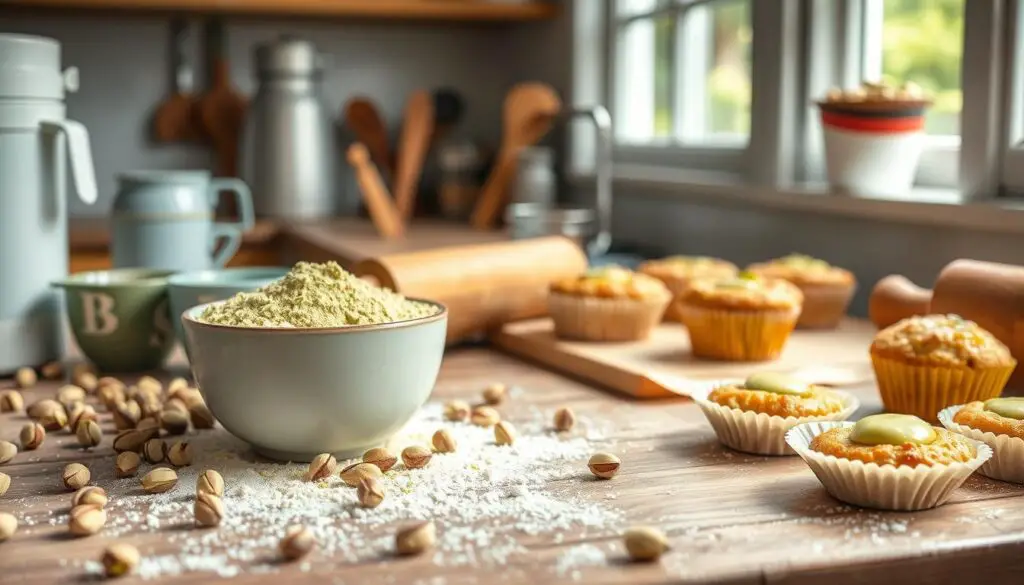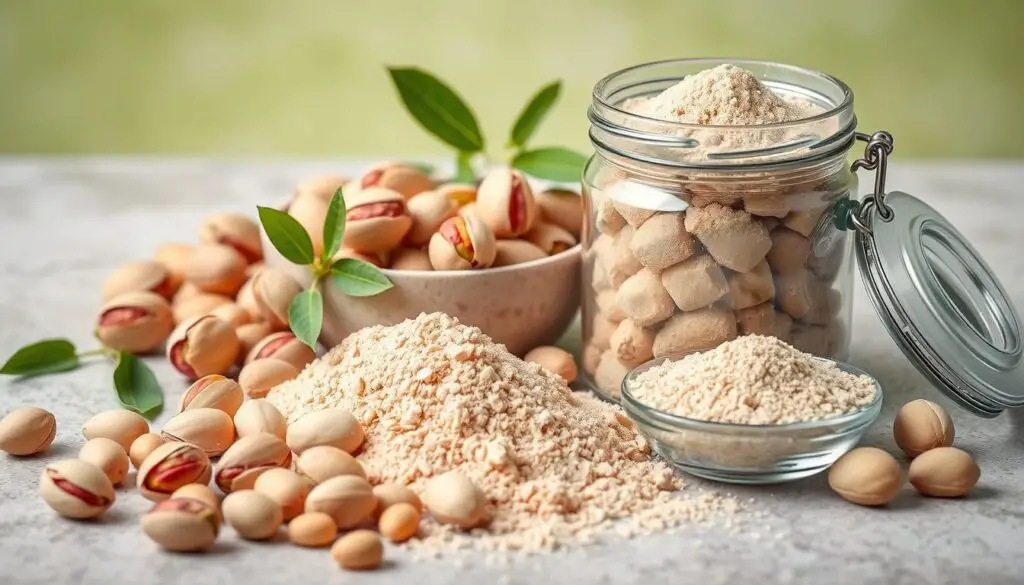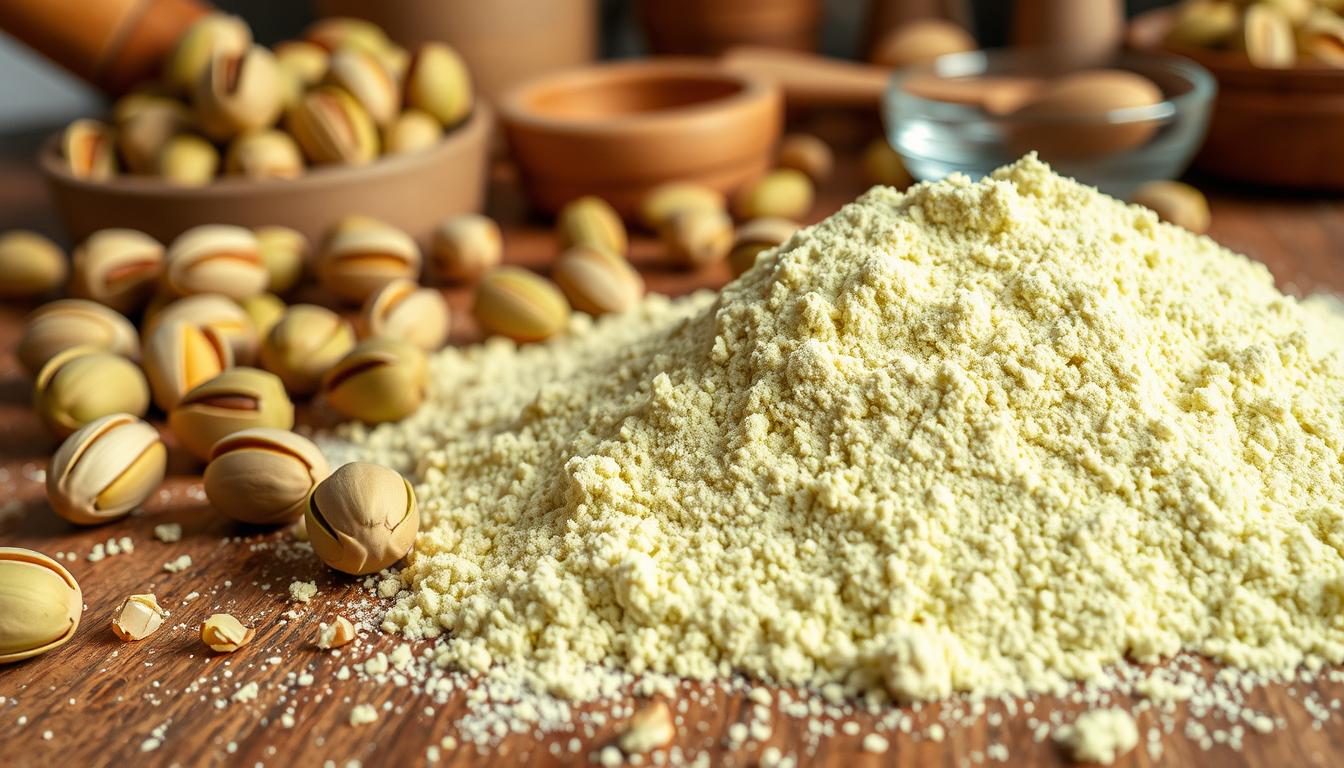Pistachio flour has emerged as a versatile and nutritious alternative to traditional wheat and nut flours. This unique ingredient offers a delightful flavor profile that tantalizes the taste buds. Explore the distinctive taste of pistachio flour and discover how it can elevate your culinary creations.
Key Takeaways
- Pistachio flour has a sweet and nutty taste with subtle earthy undertones.
- It provides a rich, buttery flavor that complements a variety of sweet and savory dishes.
- Pistachio flour is a gluten-free alternative that can be used in baking and cooking.
- The flavor of pistachio flour is versatile and can be used in both Mediterranean and Middle Eastern cuisines.
- Pistachio flour is a nutritious ingredient, rich in protein, healthy fats, and antioxidants.
Introduction to Pistachio Flour
Pistachio flour is a versatile ingredient that’s gaining popularity among health-conscious bakers and home cooks. This finely ground powder is made from whole pistachio nuts, offering a unique flavor profile and a range of nutritional benefits. Exploring the world of pistachio powder can open up new possibilities in the kitchen, from baking with pistachios to incorporating it into savory dishes.
What is Pistachio Flour?
Pistachio flour is created by grinding whole, shelled pistachios into a fine powder. The resulting flour retains the natural oils and nutrients of the nuts, making it a nutritious alternative to traditional wheat flour. Unlike some other nut flours, pistachio flour has a distinctive green hue and a delicate, pistachio nutrition-rich flavor that can enhance a variety of recipes.
Nutritional Benefits of Pistachio Flour
- High in Protein: Pistachio flour is an excellent source of plant-based protein, making it a great choice for those seeking to increase their protein intake.
- Rich in Healthy Fats: The nuts used to create pistachio flour are naturally high in unsaturated fats, such as monounsaturated and polyunsaturated fatty acids.
- Packed with Vitamins and Minerals: Pistachio flour is a good source of vitamins like vitamin B6, vitamin K, and thiamin, as well as minerals like phosphorus, copper, and manganese.
- Contains Antioxidants: Pistachios are rich in antioxidants, and this beneficial property is carried over into the flour, making it a nutritious addition to baked goods and other dishes.
By incorporating pistachio powder into your culinary creations, you can enjoy the unique flavor and the health benefits that this versatile ingredient has to offer.
Flavor Profile of Pistachio Flour
When it comes to the flavor profile of pistachio flour, the dominant notes are undoubtedly sweet and nutty. This unique combination of flavors is what makes pistachio flour a versatile ingredient, equally suited for both savory and sweet applications in the kitchen.
Sweetness and Nutty Notes
The primary taste sensation you’ll experience with pistachio flour is a delightful sweetness, reminiscent of the natural sugars found in the nuts themselves. This sweetness is complemented by a rich, buttery, and unmistakably nutty flavor that is the hallmark of pistachio. The pistachio flavor is vibrant and distinct, making it stand out among other nut flours.
Subtle Earthy Undertones
Alongside the sweet and nutty notes, pistachio flour also boasts subtle earthy undertones that add depth and complexity to its flavor profile. These earthy notes lend a certain grounded quality to the flour, preventing it from becoming overly sweet or cloying. This balance of flavors is what makes pistachio flour a unique and versatile ingredient in the culinary world.
| Flavor Attribute | Description |
|---|---|
| Sweetness | Naturally occurring sugars in pistachios provide a distinctive sweetness to the flour. |
| Nuttiness | The rich, buttery, and pronounced nutty flavor is the hallmark of pistachio flour. |
| Earthy Undertones | Subtle earthy notes add depth and complexity to the overall flavor profile. |
The unique flavor of pistachio flour makes it a versatile ingredient in both sweet and savory dishes, allowing it to shine in a variety of culinary applications.
How to Use Pistachio Flour
Pistachio flour is a versatile ingredient that can elevate both baked goods and savory dishes. Whether you’re an experienced baker or just starting to explore the world of nut flours, this guide will provide you with the insights you need to successfully incorporate pistachio flour into your cooking and baking repertoire.
Baking with Pistachio Flour
Pistachio flour can be used as a replacement for traditional wheat flour in a variety of baked goods, from cakes and cookies to muffins and scones. When substituting pistachio flour, start by replacing up to 25% of the regular flour called for in the recipe. This will lend a subtle, nutty flavor and a moist, tender texture to your baked creations.
For best results, be mindful of the other ingredients in your recipe. Pistachio flour pairs particularly well with flavors like vanilla, citrus, and chocolate. Experiment with different ratios and techniques to find the perfect balance that suits your taste preferences.
Cooking Applications
Beyond baking, pistachio flour can also be a valuable addition to savory dishes. Use it as a coating for chicken, fish, or tofu, or incorporate it into sauces, gravies, and batters for a unique nutty twist. Pistachio flour can also be used as a thickener in soups and stews, providing both flavor and texture.
When cooking with pistachio flour, start with small amounts and adjust to your liking. The flavor can be quite pronounced, so it’s important to find the right balance that complements the other ingredients in your dish.

Regardless of whether you’re baking or cooking, the versatility of pistachio flour allows you to explore new and exciting flavor combinations in the kitchen. Embrace the unique taste and texture it offers, and let your creativity shine through as you incorporate it into your favorite recipes.
Comparison with Other Nut Flours
When it comes to gluten-free baking, nut flours have become increasingly popular alternatives to traditional wheat flour. Among the versatile options, pistachio flour stands out with its unique flavor profile and nutritional benefits. Let’s explore how it compares to other popular nut flours, such as almond and hazelnut.
Almond Flour vs. Pistachio Flour
Almond flour is a well-known and widely used gluten-free flour, known for its delicate, slightly sweet nutty taste. Pistachio flour, on the other hand, offers a more pronounced, distinctive nutty flavor with a hint of sweetness. While both provide a source of protein and healthy fats, pistachio flour has a slightly higher protein content and a richer, more indulgent mouthfeel.
Hazelnut Flour vs. Pistachio Flour
Hazelnut flour is another nut-based alternative that shares some similarities with pistachio flour. Both flours have a nutty taste that can add depth and complexity to baked goods. However, pistachio flour tends to have a more pronounced, almost buttery flavor, with a slightly sweeter profile compared to the earthy, slightly bitter notes of hazelnut flour.
The choice between almond, hazelnut, or pistachio flour ultimately comes down to personal preference and the desired flavor profile for your culinary creations. Pistachio flour is an excellent option for those seeking a unique, indulgent twist on traditional gluten-free baking.
Pistachio Flour in Different Cuisines
Pistachio flour has found its way into the culinary traditions of various regions, particularly in the Mediterranean and Middle Eastern cuisines. This versatile ingredient adds a distinctive flavor and texture to a wide range of pistachio desserts and pistachio recipes, showcasing its cultural significance and adaptability.
Mediterranean Delicacies
In the sun-drenched regions of the Mediterranean, pistachio flour is a cherished ingredient. It is commonly used in baked goods, such as baklava, a flaky pastry layered with nuts and sweetened with honey. Pistachio flour also lends its subtle nutty essence to classic Italian gelato and semifreddo, creating a luxurious and indulgent treat.
Middle Eastern Dishes
Pistachio flour is a staple in many Middle Eastern cuisines, where it is celebrated for its rich, earthy flavors. It is often incorporated into traditional halva, a dense and sweet confection made with tahini and nuts. Pistachio flour also plays a crucial role in the preparation of kunafah, a beloved pastry filled with cheese and topped with a pistachio-based syrup.
“Pistachio flour adds a unique depth of flavor and a delicate crunch to both sweet and savory dishes, making it a versatile ingredient in the culinary world.”
Whether in the form of delicate pastries or robust main courses, pistachio flour has become a cherished ingredient in the kitchens of the Mediterranean and Middle East, showcasing its ability to elevate and transform a wide range of pistachio recipes.
Health Benefits of Pistachio Flour
Pistachio flour is not only a delicious gluten-free alternative to traditional flour, but it also offers a wealth of nutritional benefits. This versatile ingredient is a powerhouse of protein and healthy fats, making it a valuable addition to any healthy diet.
Rich in Protein and Healthy Fats
Pistachio flour is an excellent source of plant-based protein, providing up to 20 grams of protein per 100 grams. This high protein content can help support muscle development, tissue repair, and overall metabolic function. Additionally, pistachio flour is rich in monounsaturated and polyunsaturated fats, which have been linked to improved heart health and reduced risk of chronic diseases.
Antioxidants and Other Nutrients
Pistachios are known for their impressive antioxidant content, and this translates to the flour as well. Pistachio flour is a rich source of antioxidants, including vitamins E and C, as well as the mineral selenium. These powerful compounds can help neutralize harmful free radicals, reducing inflammation and supporting overall wellness. Furthermore, pistachio flour is a good source of fiber, vitamins, and minerals, making it a nutritious addition to any gluten-free recipe.
| Nutrient | Amount per 100g of Pistachio Flour |
|---|---|
| Protein | 20g |
| Healthy Fats (Monounsaturated and Polyunsaturated) | 45g |
| Fiber | 10g |
| Vitamin E | 2.2mg |
| Selenium | 3.1μg |

By incorporating pistachio flour into your diet, you can enjoy the numerous health benefits it provides, from its protein and healthy fat content to its impressive antioxidant profile. Whether you’re baking gluten-free treats or exploring savory pistachio nutrition dishes, this versatile flour is a fantastic choice for health-conscious cooks and bakers.
Storing and Shelf Life of Pistachio Flour
Proper storage is crucial for maintaining the quality and flavor of pistachio powder. To ensure your pistachio flour stays fresh for as long as possible, it’s important to follow best practices for storage. Let’s explore how to store this versatile ingredient and look for signs that it may have spoiled.
Best Practices for Storage
The key to preserving the freshness of pistachio flour is to store it in an airtight container, away from direct sunlight and heat. Opt for an opaque container, as exposure to light can cause the flour to lose its vibrant color and nutty flavor. Keep the container in a cool, dry place, such as a pantry or the refrigerator, to maintain the ideal temperature and humidity levels.
When it comes to baking with pistachios, freshness is paramount. Properly stored pistachio flour can typically last for 3-6 months at room temperature or up to 1 year in the refrigerator. Be sure to check the expiration date and use the flour within the recommended timeframe for optimal quality and flavor.
Signs of Spoilage
Spotting signs of spoilage in pistachio flour is essential to ensure food safety and prevent unpleasant flavors or textures in your baked goods. Keep an eye out for the following indicators that it’s time to discard the flour:
- Discoloration or changes in the flour’s appearance, such as a yellow or greenish tint
- An off or rancid smell, which can signify the flour has gone stale or developed mold
- Clumping or a gritty texture, which suggests the flour has absorbed moisture and begun to deteriorate
If you notice any of these issues, it’s best to play it safe and replace the pistachio flour. Baking with spoiled flour can not only ruin the taste and texture of your recipes but may also pose health risks.
By following proper storage techniques and being vigilant for signs of spoilage, you can ensure your pistachio powder remains fresh and flavorful, ready to elevate your baking with pistachios creations.
Recipes Featuring Pistachio Flour
Pistachio flour is a versatile ingredient that can add a delightful, nutty flavor to a wide variety of baked goods and savory dishes. Explore the following recipes that showcase the culinary potential of this unique flour.
Baked Goods with Pistachio Flour
Pistachio flour lends a rich, buttery texture and subtle sweetness to cakes, cookies, and other pastries. Try incorporating it into your favorite recipes, such as:
- Pistachio Flour Cake: A moist and flavorful cake made with a combination of pistachio flour and all-purpose flour for a delightful nutty twist.
- Pistachio Flour Macarons: These delicate French cookies are elevated with the addition of pistachio flour, creating a delectable treat.
- Pistachio Flour Shortbread Cookies: The nutty flavor of pistachio flour shines in these buttery, crumbly shortbread cookies.
Savory Dishes Incorporating Pistachio Flour
Pistachio flour isn’t limited to sweet recipes; it can also add a unique texture and flavor to savory dishes. Consider the following ideas:
- Pistachio-Crusted Chicken or Fish: Use pistachio flour as a coating for baked or pan-fried proteins, creating a delicious crunch.
- Pistachio Flour Pasta: Incorporate pistachio flour into homemade pasta dough for a vibrant green color and nutty taste.
- Pistachio Flour Breading: Substitute pistachio flour for traditional breadcrumbs when making crispy coatings for vegetables or fried items.
By exploring the versatility of pistachio flour, you can elevate your cooking and baking with its distinctive flavor and texture. Whether you’re creating sweet or savory dishes, the nutty goodness of pistachio flour is sure to delight your taste buds.
Allergies and Dietary Considerations
While pistachio flour offers a delightful gluten-free alternative, it’s crucial to consider potential nut allergies. For individuals with nut sensitivities, the consumption of pistachio flour may trigger an allergic reaction. However, for those following a gluten-free diet, this versatile ingredient can be a valuable addition to their culinary repertoire.
Nut Allergies
Pistachio flour, being derived from tree nuts, may pose a risk for those with nut allergies. Individuals with known nut allergies should exercise caution and consult with a healthcare professional before incorporating pistachio flour into their diet. It’s essential to carefully read product labels and ensure that any pistachio flour-based items do not contain potential allergens.
Gluten-Free Options
On a positive note, pistachio flour is a gluten-free flour that can be a valuable addition to the diets of those following a gluten-free lifestyle. Its unique pistachio nutrition profile and versatile culinary applications make it a fantastic choice for baking and cooking. Pistachio flour can be used in a wide range of gluten-free recipes, from baked goods to savory dishes, providing a delectable and nutritious alternative to traditional wheat-based flours.
“Pistachio flour is a game-changer for gluten-free bakers, offering a flavorful and nourishing option that can elevate any dish.”
Whether you’re managing a nut allergy or adhering to a gluten-free diet, it’s essential to be mindful of the potential implications of using pistachio flour. By understanding the considerations and taking the necessary precautions, you can safely and confidently incorporate this versatile ingredient into your culinary adventures.
Conclusion: Embrace the Flavor of Pistachio Flour
As we’ve explored, pistachio flour is a versatile and flavorful ingredient that can elevate a wide range of culinary creations. With its distinctive nutty taste, subtle sweetness, and earthy undertones, this flour offers a unique sensory experience that is sure to delight both experienced and novice home cooks.
Final Thoughts on Using Pistachio Flour
Whether you’re baking delectable pastries, whipping up savory dishes, or simply seeking to add a nutritional boost to your meals, pistachio flour is a fantastic choice. Its rich nutritional profile, including protein, healthy fats, and antioxidants, makes it a smart addition to any kitchen arsenal.
Encouragement to Experiment in the Kitchen
We encourage you to embrace the pistachio flavor and explore the many ways you can incorporate this versatile flour into your culinary repertoire. From traditional Mediterranean and Middle Eastern delicacies to innovative modern creations, the possibilities are endless. So, let your creativity shine and discover the wonders that pistachio flour can bring to your dishes.
